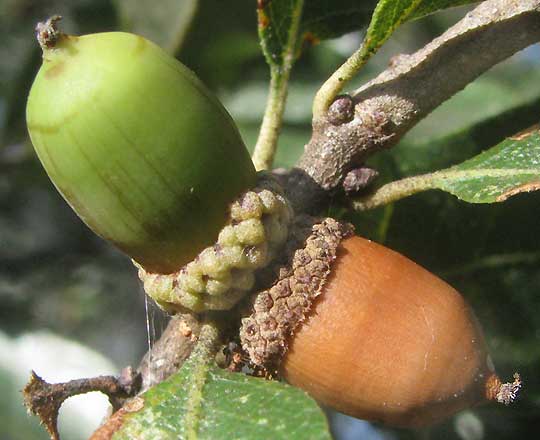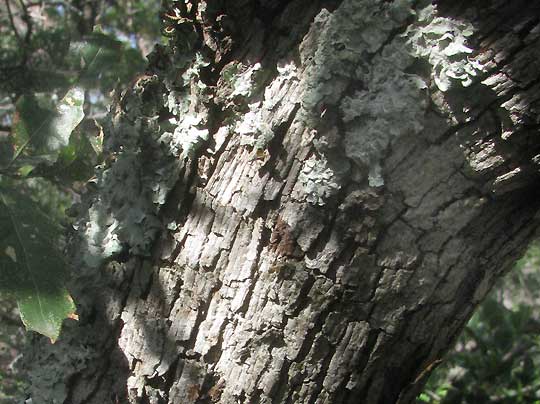Excerpts from Jim Conrad's
Naturalist Newsletter

from the October 6, 2013 Newsletter issued from the Frio Canyon Nature Education Center in the valley of the Dry Frio River in northern Uvalde County, southwestern Texas, on the southern border of the Edwards Plateau; elevation ~1750m (~5750 ft); N29.62°, W99.86°; USA
SHIN OAK
We've already met the Sandpaper Oak, Quercus pungens, a mostly Mexican oak occurring here and there in the US's arid Southwest. It's shown at http://www.backyardnature.net/n/w/qpungens.htm.
The Sandpaper Oaks atop our hill reach only about chest high. Therefore, the other day I was astonished when some oaks presented themselves atop some neighboring hills looking very much like Sandpaper Oak, but they were about 20 feet high (6m). Leaves and acorns are shown at the top of this page. A close-up of the robust acorns with their cups covering only a small part of the nuts' bottoms appears below:

The leaves look very much like Sandpaper Oak leaves. Happily, the oak section of the online Flora of North America is available, so before long I was learning why I might find tree-sized specimens of an oak species that until now I knew only as shrubs.
Best I can tell, this week's trees were Vasey Shin Oaks, here just called Shin Oaks, QUERCUS VASEYANA. Experts agree that Shin Oaks look very much like Sandpaper Oaks, occur over pretty much the same area as Sandpaper Oaks, and frequently hybridize with Sandpaper Oaks. In fact, in the past, Shin Oaks were regarded as merely a variety of Sandpaper Oak.
However, the Flora of North America points out that the cups of Sandpaper Oak's acorns cover more of the nut than they do on Shin Oak acorns. I haven't seen the Sandpaper Oak's acorns, but the Flora also says that the leaves of Sandpaper Oaks are "strongly undulate," undulate meaning that they're wavy. In contrast, Shin Oak leaves are more or less flat. Leaves shown on our Sandpaper Oak page are indeed a bit wavy and curved along the margins, while leaves seen in our above pictures are fairly flat. The acorns in our pictures perfectly match internet pictures of acorns of Vasey Shin Oaks. Below, you can see our Shin Oak's dark brown, furrowed and somewhat exfoliating bark:

Shin Oaks are endemic just to western Texas and nearby arid Mexico where they occupy dry limestone slopes, oak and mesquite woodlands, juniper woodlands, and canyons and ravines in otherwise dry, open grasslands.